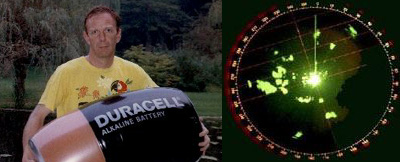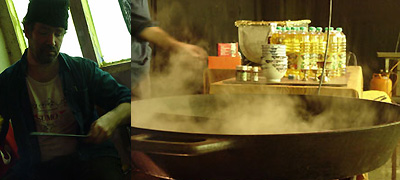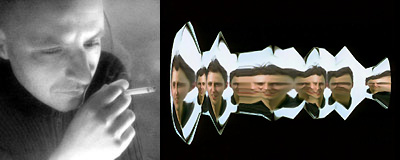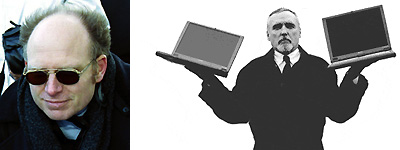The A-Z of media art history
A documentary on the history of media art starring Blixa Bargeld, Christoph
Blase, Klaus vom Bruch, Mike Hentz, Michael Saup, Florian Schneider and Hermann
Vaske.
Assignment: Curate and design a major exhibition celebrating the history of media
art. consider the list of artists to be included and the phenomena of media art.
Submit a visual design for the exhibition and remember that the design should
reflect both in content and form the nature of media art.
The idea behind the project "The A-Z of media art history" is not to conceive a
traditional exhibition to celebrate media art but to interview contemporary media
artists, writers, musicians and art directors on how they see their work in
relation to media art history. Each letter of the alphabet represents a key
element in the history of media art. In talking to the interview partners the
context of their work with regard to media art history is
established, bridging the gap between history and contemporary works. The
proposal poses questions without providing answers - the answers should be given
by the individual participants. The interviews are captured on video and the
final proposal for the exhibition celebrating the history of media art is a
documentary with the statements of the media artists, musicians and writers. In
the beginning of the video the invited participants are introduced with visual
support of some of their works. The rest of the video is dedicated to the journey
through media art history together with the participating artists, musicians and
writers.

Blixa Bargeld
Blixa Bargeld (Christian Emmerich), born in 1959 in Berlin is best known as as
lead vocalist of the German band "Einstürzende Neubauten" but also works as
composer, author, actor, singer, musician, performer and lecturer in almost any
field of interpretative art. He is also a permanent member of Nick Cave &The Bad
Seeds. His band, Einstürzende Neubauten (translated "collapsing" or "imploding
new buildings") was formed 1980 in Berlin as a part of the Die Geniale
Dilletanten, a dadaistic musical movement that had as a common goal to break down
all musical conventions. Einstürzende Neubauten gained much of their recognition
because of their use of metal plates, electric drills, metal cutters and circle
saws as instruments. The "Concerto for Voices and Machinery" was performed at the
Institution of Contemporary Art in London early 1984. The aim was to incoorperate
the sounds performed by the performers into an orchestral arrangement. The
instrumentation were made up by concrete mixers, electric saws, acetylene torhes
and generators. More recent works of Blixa Bargeld include the linguistic
performance "Rede / Speech"╩which he performed in Munich, Halle, Amsterdam.
"serialbathroomdummyrun" a photo Exhibition at Galerie&Kunsthandel Mirko Mayer,
Köln and a concert at Meltdown Festival, Royal Festival Hall, London together
with Nick Cave &The Bad Seeds.

Christoph Blase
Christoph Blase works as an art critic in Berlin. In 1995 he developed Blitz
Review (www.blitzreview.de), one of the first online art forums which started as a mailinglist on the
server of "The Thing". In the same year the Blitzreview website was presented in
Vienna. Blitzreview is comment and information at the same time, everybody is
invited to send comments on existing reviews - the feedback is moderated and
interesting texts are published on the website Since 2000 Blitzreview has its own
server in Berlin. Christoph Blase works as an art critic for Kunst-Bulletin and
Kunstforum and writes for F.A.Z. (Frankfurter Allgemeine Zeitung).

Klaus vom Bruch
Klaus vom Bruch was born in 1952 in Cologne. From 1975-76 he studied at
California Institute of the Arts, Valencia, California and was professor for
media art at Hochschule für Gestaltung (State College of Design), Karlsruhe from
1992 - 1998. In 1999 he held a professorship for media art at the Akademie der
Bildenden Künste (academy of fine art), München and one year later he was a
visiting professor at Columbia University, New York. Klaus vom Bruch started as
an video artist in the mid 70s and worked with video as an artistic medium for
over ten years (he produced his last videotape in 1986). In these times Klaus vom
Bruch was much attracted by feminism, this was partly due to his relationship and
collaboration with the German video artist Ulrike Rosenbach. Works from this
period include the series "Die Harten und die Weichen" and "Warum wir Männer die
Technik so lieben". In the mid 80s Klaus vom Bruchs broadened the range of his
works from the immaterial realm of the electronic media towards sculpture. The
observer became part of the installations, e.g. in the piece "Radar Raum", where
visitors were tracked and visualized by a radar system, setup in the gallery
space. Klaus vom Bruch's works were exhibited at the "Biennale di Venezia",
International Pavillon, Venice in 1984, "documenta 8" , Museum Fridericianum,
Kassel, 1987 and in the exhibition "Video - Skulptur" , DuMont Kunsthalle,
Cologne in 1989.

Mike Hentz
Mike Hentz was born in New Jersey in 1954. He works as a visual artist,
performer, sculptor, musician, and media artist. Since 1974 he is involved with
international exhibitions, performances and media projects, including Documenta 8
& 9. Mike Hentz co-founded groups and networks such as Minus Delta T, Ponton
European Media Art Lab and Van Gogh TV. The works of the Minus Delta T defined
the notion of "climate" in an artistic context. The artwork is for Hentz not only
a picture or a sculpture but an authentic atmosphere. "The Bangkok-Projekt" was
announced as the biggest performance of all times. In 1982 Minus Delta T started
to transport a monolith weighing five tons from Wales to New Delhi. On its way
the rock was blessed by the pope and the Dalai Lama. In 1986 Mike Hentz founded
Ponton together with Karel Dudesek. In 1989 he set up a stationary laboratory
(Ponton European Media Art Lab) where artists, students and scientists researched
in the field of artist-television and artist-radio. VAN GOGH TV (founded in 1986)
gathered artists from all over the world working in the field of new media. Group
projects were broadcasted internationally via satellite and cable. Current works
of Mike Hentz include workshops and lectures on the topic "Heimat" (homeland) and
"Visa".

Michael Saup
Michael Saup was born in 1961. He works as a media artist in the context of
realtime interaction and computer generated images and sound. His works in the
early 1990s at the Institut für neue Medien (institute for new media) in
Frankfurt concentrated on realtime interaction of sound and image. Later works
included installations and the usage of the internet as an artistic medium. In
1992 Michael Saup founded "Supreme Particles" a loose organization of artists,
scientist and researchers in Frankfurt and San Francisco. He collaborated very
effectively with Steina Vasulka, one of the pioneers of video art and worked
together with Peter Gabriel. His work was shown at imagina, monte carlo in 1993,
at siggraph, orlando, florida in 1994 and at the "Biennale di Venezia" in 1995.
In 1995 he won the award prix ars electronica for interactive art. From 1990 -
1994 Michael saup worked as an assistent at the Institut für Neue Medien
(institute for new media), Städelschule Frankfurt. Since 1999 he is a professor
for media art at Staatliche Hochschule für Gestaltung (State College of Design)
in Karlsruhe.

Florian Schneider
Florian Schneider was born in Düsseldorf in 1947. He studied transverse flute at
the Conservatory in Düsseldorf.In 1970 he founded together with Ralf Hütter the
band "Kraftwerk" focusing on electronically generated music. The music of
Kraftwerk is often supported by abstract graphics, starting with the
konstructivist album cover of Mensch-Maschine (the man machine) in 1978. In the
1980s the Kraftwerk members started to replace themselves with robots during
their concert performances. The music video accompanying the 1986 Electric Cafe
album introduced 3D renderings commercial music videos for the first time. The 3D
renderings of the band members for the video and the cover artwork were designed
by Rebecca Allen (at that time New York Institute of Technology). From 1999-2000
Florian Schneider was professor for sounddesign and performance at Staatliche
Hochschule für Gestaltung (State School of Design) in Karlsruhe.

Hermann Vaske
Hermann Vaske was born in 1956, he studied at the Berliner Hochschule der Künste
(college of fine art) and the American Film Institute in Los Angeles. From
1982-1994 Vaske, whom the Magazine Tomorrow called 'the European creative guru',
worked as an creative and Executive Creative Director in advertising agencies in
Hamburg, New York, Düsseldorf and London (Saatchi & Saatchi, Lowe & Partner,
Springer & Jacoby). His campaigns won many awards, including Cannes Golden Clios,
the Golden Award of Montreux and a Gold Award at the New York Film & Television
Festival. In 1995 Vaske founded Hermann Vaske's Emotional Network, an advertising
agency and production company in Frankfurt which combines his own writing,
producing and directing talents with those of other highly creative people such
as Wim Wenders, Damien Hirst, Malcolm Mc Laren and Julian Schnabel. Advertising
campaigns by Vaske include Mercedes, BMW, Volkswagen and British Airways. In 1999
Hermann Vaske won the Grimme Price, German's TV Oscar, for his two-and-a-half
hour documentary, "The A-Z of seperating People from Their Money". Vaske explores
the relation of art, advertising and creativity by interviewing artists,
politicians, designers and religious leaders like the Dalai Lama.
A L'Arte Di Rumori - The Art Of Noise
Mr. Bargeld, in 1913 a member of the Futurists, the Italian artist Luigi Russolo,
wrote in his manifesto "L'Arte Di Rumori" (The Art Of Noise): "Ancient life was
all silence. In the nineteenth century, with the invention of the machine, noise
was born. Today, noise triumphs and reigns supreme over the sensibilities of
men." With his instrument called "Intonarumori" he introduced for the first time
ever the aspect of noise as a potential for art. How do you see the relation of
the first musical pieces of your band "Einstürzende Neubauten" where you used
electric drills, metal cutters and circle saws as instruments and Russolo's
ideas? (top)
B Bauhaus
Mr. Bruch, the idea of the Bauhaus from 1919-1933 was to bring together design,
visual arts, dance, theatre, ceramics and new technology. Walter Gropius talked
about art and technology as a new unity and that the machine becomes a modern
means of design. Contemporary media centres like ZKM (center for art and media)
and Hochschule für Gestaltung (State College of Design) in Karlsruhe or New
Bauhaus in Weimar are often called the "descendants" of the Bauhaus. You have
been the dean of the media art faculty of State College of Design in Karlsruhe
for six years. Where would you see the main differences between now and then?
(top)
C Cybernetic Serendipity
Mr. Blase, in 1968 Jasia Reichardt curated an art show called "Cybernetic
Serendipity" in the Institute of Contemporary Arts in London. It was claimed to
be the first large scale exhibition of "post-machine" art. The exhibits included
computer printouts of musical analysis, computer designed choreography and
computer generated texts and poems, so to say the first semi intelligent
computerprograms used in the context of art. However the exhibition was highly
critcized and has not become very popular. What might have been the reasons?
(top)
D Dada
Mr. Bargeld, the idea of Dadaism, which started in Zurich in the mid 1910s was to
attack the value systems of society. The dadaist movement had strong destructive
elements and during the performances the audience was often insulted or even
attacked by the performers. Could you tell how this aspect was transformed
through performance art, happening and punk to the 80s performances of
Einstuerznde Neubauten?
(top)
E E.A.T.
Mr. Saup, in 1965 Billy Kluver, John Cage and Robert Rauschenberg started to
collaborate on a long term art and technology extravaganza leading to the
exhibition series "Nine Evenings" and finally to the foundation of Experiments in
Art and Technology (E.A.T.), a group of artists and scientists working together
on artistic but also commercial projects. In 1992 you founded with "Supreme
Particles" a network of people from different disciplines with the intention to
work both in an artistic and an applied context (here I'm thinking especially of
the projects for the Frankfurt airport and the collaboration with Peter Gabriel).
Do you see any relation between Supreme Particles and E.A.T.?
(top)
F Le Futurisme
Mr. Blase, On February 20th, 1909 the French newspaper "Le Figaro" published an
article on its frontpage called "le futurisme". The text was written by Filippo
Thomaso Marinetti and was the manifesto for a new way of thinking about art, the
art of speed and noises called "Futurism". For the first time artist were
completely aware of new media technologies and wanted to have their works shown
in the media. Many manifestos on the topic of new media and art were published
from Russolo's "L'Arte di Rumori" to Marinetti's "La Radia" and Fontana's
"Manifesti dello Spazialismo" - do we have current media art manifestos?
(top)
G Guerilla Television
Mr. Hentz, in 1971 Michael Shamberg and the raindance Corp. published Guerilla
Television. As framed in their first manifesto, the goal of the video guerilla
was nothing less than a reshaping of the structure of information in America.
Guerilla TV also introduced the concept of narrowcasting and broadcasting, e.g.
presenting local shows on trucks. The idea of Ponton with its first mobile unit
at the media art festival Ars Electronica in Linz in 1986 and later with the
installation of Ponton European Media Art Lab in Hamburg in 1989. Do you see
parallels between Guerilla TV and Ponton?
(top)
H Holy Technology
Mr. Vaske, in your latest movie "The Ten Commandments Of Creativity" we see how
Dennis Hopper - in the role of a creative director - experiences the nightmare of
every artist: he runs out of ideas. Peter Ustinov - playing the role of God -
sends him two PC-Laptops with the ten commandments of creativity. In your
opinion, has technology always been a catalysator of creative ideas?
(top)
I Interactivity
Mr. Saup, we see interactivity developing from early 19th century movie machines
(the user is able to control the speed of of the images) to early definitions of
interactivity with regard to the computer where interactivity in a first step
just meant to interrupt the system (pressing a stop button). More advanced
systems allowed selection (WWW and portal sites for example) but the really
interesting step is towards creative conversation - a system that adjusts itself.
Your works developed from simple realtime control - the abekas a60
harddiskrecorder is controlled by a musical instrument (a666) to intelligent
systems like the tunnel installation in the Frankfurt airport where factors like
time of the day or the number of passengers determine audio and visual output.
What would be your definition of interactivity in the context of your work?
(top)
J John Cage
Mr. Bargeld, John Cage is for sure one of the central figures for the development
of media art. Originally being a composer John Cage did not only concentrated on
music but influenced almost all forms of creativity. In the 1960s he worked
together with Fluxus artist all around the world, and was musical advisor for
Merce Cunningham's Dance Company. In his later years Cage was strongly influenced
by Asian Zen philosophies and Buddhism. You are working as a composer, author,
actor, singer, musician, performer and lecturer in almost any field of
interpretative art - do you think that working with media fostersand has always
encouraged such a universal orientation which is very different e.g. from the way
a traditional artist, let's say a painter, works?
(top)
K Kinetic Art
Mr. Saup, Laszlo Moholy Nagy claimed that scientific models can be the foundation
for artistic principles. Moholy Nagy developed light space modulators
(Lichtraummodulatoren) in the 1920s. These objects had two functions: to be a
machine artwork and to be an instrument for the creation of new spaces - so to
say virtual light spaces which strongly influenced Kinetic art, the painting with
light. You often mention the strong influence of Oskar Fischinger's light pieces
and experimental movies in your own work ("Zur Physik der Kunst" - on the physics
of art). What role does kinetic art and light play in your own work?
(top)
L Lumia
Mr. Saup, this leads me to the second question: in the 1920s Thomas Wilfred
worked hard on the connection between light and sound. He called this new form of
art "Lumia". Various works included synaesthetic experiments (cf. Arnold
Schönberg and Oskar Kokoschka, coming from music respectively fine arts). Oskar
Fischinger was interested in the same ideas and created the first electronically
generated soundtrack by drawing on the optical track of celluloid film which was
normally used for the storage of sound. In your works from the series
"Interfacing Audio and Images" this aspect of connecting sound and images is very
strong - which parallels do you draw from your work to the beginnings of Lumia?
(top)
M Man Machine
Mr. Schneider, with the 1978 album "Menschmaschine" (man machine) Kraftwerk
emphasized the concept of the artist becoming a machine - a concept that was
applied for example in Andy Warhol's Factory as well as in Stelarc's body
performances. During Kraftwerk concerts the musicians are replaced by robots. How
do you see this dualistic idea of mind and body or hardware and software, master
and slave, etc. realized in your own work? and do you see connections to other
artistic concepts of the man machine?
(top)
N Nine Evenings
Mr. Blase, in October 1966 Billy Kluver together with John Cage and Robert
Rauschenberg organized "Nine Evenings: Theater and Engineering" at the 69th
Regimental Armory in New York City. According to most of the critics the show was
a complete faillure although it was the first large exhibition of electronically
responsive media artworks - the only positive result might have been the
excellent rapport that was established between some artists and engineers
leading to many successful art and technology mergers afterwards. Was the
faillure only caused because of technological reasons or do you see a possible
reason in the first encounter of artists and scientists resulting in a mutual
misunderstanding? How has this relation developed in the course of media art
history?
(top)
O Optofonetik
Mr. Schneider, Thomas Wilfred's clavilux, Viking Eggeling's animation experiments
and the concept of Optofonetik were early examples of connecting sound and light.
Kraftwerk concerts tend to have a strong visual impact, too, and well designed
and paced light sequences. What are the concepts behind those elements and do you
see them in relation to those early experiments?
(top)
P The Pepsi Pavilion
Mr. Vaske, one of the biggest projects of E.A.T. was the conception and
realization of the art and technology pavilion for the Pepsi-Cola Company on the
Expo '70 in Osaka, Japan. E.A.T. built a huge inflatable dome which was covered
with mirror foil inside and which was enclosed by an artificial cloud outside.
compared to Diller and Scofidio's "Blur Building" planned in Yverdon-les-Bains
for the Expo 2002 in Switzerland the Pepsi Pavillion might have been one of the
first examples of "experience design". Do you see many such examples from media
art that can be effectively used for creating "experiences" in a commercial
context?
(top)
Q Quantum Physics
Mr. Saup, we already talked about the the relation of science and art in your
work - "Zur Physik der Kunst" (on the physics of art) is a good example here. How
would you define yourself in this context, as an artist, a scientist or and
artist-engineer?
(top)
R Ready Made
Mr. Hentz, the idea of the Ready Made introduced by Marcel Duchamp in 1913 with
the bicycle wheel mounted on a stool always implied the aspect of touching and
interaction. This introduced a new concept to the art world because traditionally
an artwork shouldn't be touched - visitors should keep a distance. Your idea of
an authentic atmosphere goes very much in the same direction, to discard the
distance between observer and artwork - letting the observer feel the "climate"
created by the artwork. Which pieces of media art have the most challenging
climate for you?
(top)
S Satellite
Mr. Hentz, in 1980 Kit Galloway and Sherrie Rabinowitz set up a live satellite
link between New York City and Los Angeles - the project called "Hole in Space"
consisted of two large videodisplays set up in either city thus allowing people
on the street to use the installation as a giant video phone. Other artists like
Nam June Paik used satellite connections for artistic shows with participants
distributed around the globe. With VanGogh TV you set up a communication and
collaboration platform for artists working with television as a medium. It
enabled people from all around the world to collaborate in realtime. How were the
outcomes of this project different from other artistic satellite TV projects?
(top)
T Trautonium
Mr. Schneider, Oskar Sala is famous for playing the Trautonium, the first
electronic instrument. The Trautonium was developed by the electrical engineer
Dr. Friedrich Adolf Trautwein and first exhibited in Germany in 1930. Paul
Hindemith wrote "Concertina for Trautonium and Orchestra" and Oskar Sala composed
the soundtrack for Hitchcock's "The Birds" for the Trautonium. How do you see the
impact of the Trautonium for the further development of electronic music?
(top)
U Ubiquitous Computing
Mr. Saup, Mark Weiser, the father of ubiquitous computing describes the concept
of ubiquitous computing as "the third wave in computing, just now beginning.
First were mainframes, each shared by lots of people. Now we are in the personal
computing era, person and machine staring uneasily at each other across the
desktop. Next comes ubiquitous computing, or the age of calm technology, when
technology recedes into the background of our lives." (Mark Weiser,
http://www.ubiq.com/hypertext/weiser/UbiHome.html). How did you see the computer
being integrated more and more seemlessly into media art works in the last ten
years?
(top)
V VideoDisc
Mr. Bruch, in 1984 Lynn Hershman introduced the concept of non-linearity in the
video art world. Her non-linear video disc work "Lorna" offered the user several
possible plots depending on his decision after each sequence. However most of the
video artist at that time and still today produce linear video pieces. How do you
explain this decision against the feature of user interaction in video art
pieces?
(top)
W Who is Who
Please, Mr. Blase, tell us your top ten media artist list.
(top)
X X-Ray
Mr. Bruch, new technologies also offer new ways to acquire images - things that
are normally invisible become visible. The idea of using X-Ray images in an
artistic context goes back to Laszlo Moholy Nagy who experimented with this
technology in the 1920s. You used radar images of persons, landscapes and famous
buildings in your projects. Often these technologies are developed respectively
improved by the military, night vision, thermo imaging and radar to name only a
few - how do you see the media artist's role in using these technologies?
(top)
Y Y2K
Mr. Saup, Y2K predicted the big computer crash. One of your project ideas deals
with a large number of i-mac computers organized in a cricle which reboot
constantly in a clockwise manner. The failure of technology is a common aspect of
many media artworks, either as a creative decision or as an unwanted side effect.
Do you see your concept in any relation to the failure of technology of
previously realized media artworks?
(top)
Z Zukunft (German for: future)
Mr. Bargeld, Mr. Blase, Mr. Bruch, Mr. Hentz, Mr.
Saup, Mr. Schneider and Mr. Vaske, what will the future of media art look like?
(top)
back | fwinkler UCLA
|

